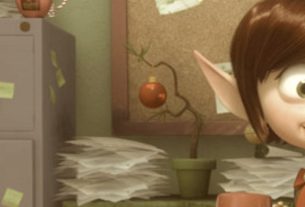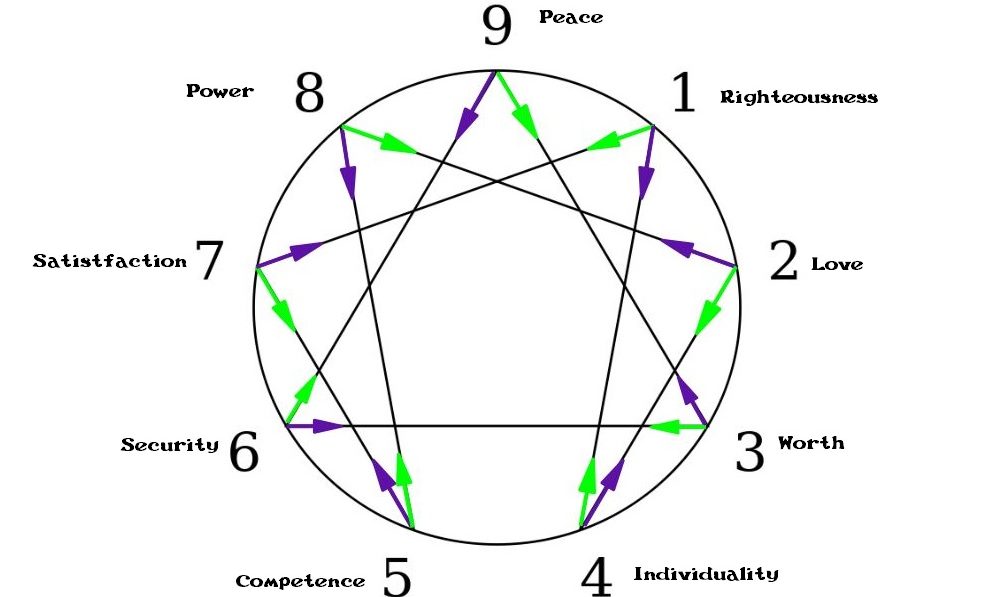
I like taking surveys and quizzes, so personality tests are hard to resist, whether it’s figuring out what flavor of ice cream I am or what Hogwarts house I belong in. It doesn’t matter if the results are obviously wrong, or the answer is so vague it could fit anybody, or if even a dead-on fit isn’t scientifically accurate. It’s just fun.
But a few years ago a friend of mine sent me this personality test and the results were, for a change, genuinely enlightening.
Holy cow, I thought. This isn’t some fun quiz. This is my entire life spelled out in excruciating detail. This doesn’t merely describe all my idiosyncrasies, it makes them make sense.
Enneagram personality typing developed in the 1960s as part of a system for attaining self-actualization, drawing from a variety of spiritual traditions around the world. Maybe the “woo-woo”-y nature of this history is what has kept it from being more well-known in the mainstream. Or maybe it’s just scarier than more feel-good systems that simply describe what you’re like: since the focus of the Enneagram is on self-improvement, it forces you to face up to your worst faults.
Because even if you don’t buy into the spiritual nature of a lot of the literature and background, the psychology is sound and practical. Everyone is driven by different needs and desires, and everyone reacts to situations in different ways. The Enneagram groups people by nine basic motivations that unconsciously affect choices and habits. Everyone can feel any of these motivations at times, but they tend toward one in particular, which shapes their worldview so deeply they may not even realize other people are coming from a completely different way of thinking.
What makes Enneatyping unique among personality typing is it focuses not so much on WHAT you do, but HOW and WHY you do what you do. Your core motivation manifests in certain patterns of behavior, but people of the same type might not necessarily look exactly alike on a checklist of traits. Each type has the potential for great good and great evil, depending on how they are controlled by their motivations.
Your Enneatype makes some virtues come naturally to you (as a Type 9, motivated by peace, I’m extremely easygoing and patient). On the flip side, that same motivation makes you more susceptible to slipping into certain bad habits—each type roughly corresponds to one of the Seven (plus two—see, roughly) Deadly Sins (as a Type 9, mine’s Sloth). The same general need—the desire for peace in my case—can lead in two very different directions. See how that works?
The nine-pointed star figure above shows how each of the nine tendencies can relate to each other. The green arrows point in the “direction of integration,” or toward the type that comes easiest to the behaviors you are most lacking. In order to counteract my Sloth, I need to integrate more traits associated with Type 3: industriousness and ambition. The purple arrows point in the “direction of disintegration,” or stress. I know that when I start showing anxiety like a Type 6, I definitely need to make some changes in my life, or things will go downhill fast.
The beauty of this is how it acknowledges that there’s no one-size-fits-all when it comes to self-improvement advice. A Nine like me doesn’t need to be told to remember to take other people’s feelings into consideration, but a Type 8 might. Other people should rest when they feel like resting, but most of the time when I feel like resting, what I really need to do is exercise. It also explains why some people seem to be speaking a different language when they try to give advice. I had to laugh when I found this note in my research: “Nines find goal-setting quite helpful. All the goal-setting literature is written by Threes, so books will be intimidating, but setting a few modest goals would be helpful for you.” Of course goal-setting literature is written by Threes, and of course that’s why it seems impossible to me as a Nine! Knowing these basic differences in worldview makes it much easier to evaluate things people say that don’t always make sense. It also should help YOU think about how what you say might come across to someone else: just because a piece of advice seems obvious to you, doesn’t mean it won’t feel completely foreign to others!
Once you start digging into how Enneagram theory works, you could get overwhelmed by variables. You’ll see stuff about “wings” and “instincts” and “tritypes” or “fixes.” Don’t worry about that yet. I’m going to focus here just on introducing you to the basic core types through how they manifest in some familiar characters.
Type One
Sometimes Called: The Reformer, the Critic, or the Perfectionist
Basic Desire: to be RIGHT. Avoids being improper
Known for: integrity and orderliness
But on the flip side: judgmental. Your Deadly Sin is: anger, usually in the form of simmering resentment and self-righteousness

If you want a perfect example of how no type is either good or bad all in one place, crack open a copy of Harry Potter and the Order of the Phoenix, and watch two textbook Type Ones go head-to-head: Hermione Granger vs. Dolores Umbridge. Both live by The Rules (though WHICH Rules might differ). Both hate to be wrong. But Hermione directs that energy toward fighting injustice while Umbridge uses it to oppress others. A One can be a noble paladin or a ruthless inquisitor, just as long as their alignment is Lawful.
Type Two
Sometimes Called: the Helper, the Giver, or the Nurturer
Basic Desire: to be loved and appreciated. Always afraid of being useless
Known for being: generous people-people
But on the flip side: can be manipulative and overinvolved. Your Deadly Sin is: Pride

The stereotypical fictional Two would be Molly Weasley: the bustling mother-figure, caring and tough at the same time. But to understand the type a little more deeply, take a look at a male Two, Peeta Mellark. Note not only how giving he is, but also how stubbornly he insists on sacrificing himself for the woman he loves, the worse things get. That’s that pride sneaking in, “No, only I can save Katniss, I need to help her!” Also note the way he charms an audience, how tuned he is to the emotional vibe to manipulate them into loving Katniss, too. Don’t look at him brainwashed, though, that throws a wrench in the pattern. Which is not to say there aren’t naturally unhealthy twos. Someone just tried to convince me that Anakin Skywalker was a Two, and I doubted at first, but the more I think about it, the more I might agree.
Type Three
Sometimes Called: the Achiever or Performer
Basic Desire: to have worth, status, applause. Second place is the first loser
Known for being: confident and driven
But on the flip side: workaholics so image-focused they think their mask is them, can be outright narcissists. Your Deadly Sin is: deceit and vanity

Not to start every description with a Harry Potter comparison, but Threes are Slytherin.* They are driven by ambition. As a Nine I confess that finding a good hero for this description was difficult for me because Type Three embodies my own weak spot: I’m kind of subconsciously repulsed by ambition. Rumor is that J.K. Rowling is a Nine, too, which accounts for how, even though she told us Slytherin does not equal Evil, she had trouble showing us that: even not-evil Slughorn was still unpleasant. But in real life there are healthy Threes doing great things with their get-up-and-go attitudes: when I saw that one of my personal heroes, Paul McCartney, had been typed as a Three, my gut response was “HOW COULD YOU SAY SUCH A THING ABOUT MY HERO oh wait, you’re right. He is. Exactly.” So.
Here’s a Three hero who is yes, quite faulty, but not completely horrible: Tony Stark. He shows the world a carefree playboy, reveling in attention, but, at the same time, he’s focused on inventing and constantly improving those inventions, doing better than the best he can, being devastated by failures and subconsciously trying to impress his late father.
*But not all Slytherins are Threes—there’s a good chance Draco Malfoy is a Two, for example. Think of it as squares and rectangles: Type Threes are squares in the broader rectangle of Slytherin.
Type Four
Sometimes Called: the Individualist, the Romantic, or the Artist
Basic Desire: to be unique, to be heard and understood, to find meaning
Known for being: creative and intuitive
But on the flip side: can be moody and temperamental. Your Deadly Sin is: envy
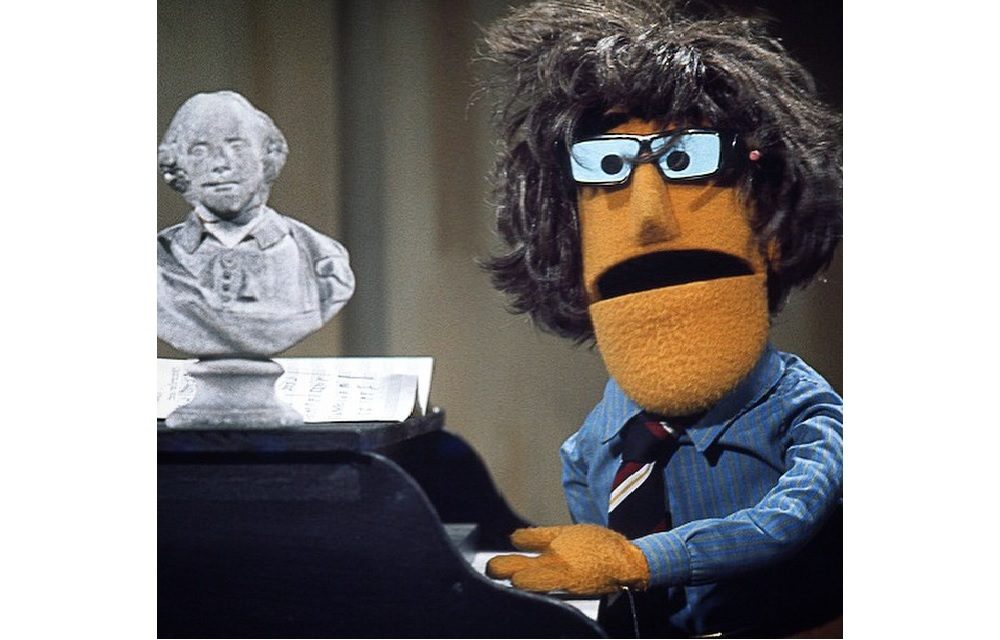
I thought I might be a Four at first, had Nine not been so DEAD-ON ACCURATE instead. All creative people want to be heard, to be unique, to express something meaningful. But FOURS fall closer to the stereotype of the Suffering Artist, wallowing in melodrama. I found a beautiful description of Four that moves us away from stereotypes and into potential: Fours see what is missing and seek to fill it. So yes, they are prone to envy and fits of self-loathing over what they’re personally missing, but they take steps to add so much to an incomplete world. For all her wallowing in the “depths of despair,” Anne Shirley filled the holes in the lives of the Cuthberts when she came to Green Gables, with beauty and laughter and passion. It’s what Fours do. They fill in the blanks.
That’s for all the Fours I know that are prone to not seeing the beauty in themselves.
Type Five
Sometimes Called: the Investigator or the Observer
Basic Desire: to be competent and knowledgeable
Known for being: objective and scientific
But on the flip side: can get stuck in an ivory tower. Your Deadly Sin is: avarice, in the form of hoarding yourself away

Fives are nerds.* They defend themselves against the world by accumulating information: the more they know, the more secure they will be. And the more they cut out emotional influence, keep objective and cool, the more secure they will be. Mad scientists are fives, focused on their discoveries to the point of ignoring—or not caring—the effects they might have on the world at large. But Queen Elsa is a Five as well, isolating herself as she attempts to gain control over her magic… which, in its coldness, is a rather fiveish power in and of itself.
*But, like Slytherin Threes, not all nerds are Fives (some of us are Nines, for example). And to be honest, maybe it’s more of a Venn diagram because I’m not sure I’d call Queen Elsa a nerd, either. But she’s definitely a Five.
Type Six
Sometimes Called: the Loyalist, the Questioner, or the Skeptic. Or the Loyal Skeptic
Basic Desire: security, certainty
Known for being: loyal, thoughtful planners
But on the flip side: suspicious, sometimes to the point of paranoia, have issues with authority, can hold a strong “us vs. them” mentality. Your Deadly Sin is: fear

Type 6 is a clear example of the Enneagram’s focus on motivation rather than outward appearance. What do Peter Pettigrew and Katniss Everdeen really have in common, you think? One seeks out and clings to powerful “friends” to protect him from his fears, while the other is a “counterphobic” Six, attacking her fears head-on and not trusting authority a bit. But they’re both ultimately driven by the need for security, and by loyalty to the people who represent that security.
Sixes are survivalists. My Six husband describes the mental process of walking into a new place like this: “It all happens in the first few seconds: I scope out all the exits. I scan for any possible sources of danger. Once I’ve sorted out a contingency plan for any trouble that might turn up in the area, then I can relax.” Type 6 is associated with fear and anxiety, but the way they deal with that fear is what ultimately shows who they are. Given a noble cause and a bond of loyalty to a good friend, a humble, overlooked Six can even earn the title of “Samwise the Brave”… even if he doesn’t believe you.
Type Seven
Sometimes Called: the Enthusiast, the Adventurer, or the Entertainer
Basic Desire: to be satisfied
Known for being: optimistic and energetic, making the best of everything
But on the flip side: can tend toward recklessness and overindulgence. Your Deadly Sin is: gluttony

Pixar’s Inside Out was not just an anthropomorphic look inside the brain, it was an anthropomorphic look inside a TYPE SEVEN’S brain. Joy is the leader of the emotions, taking charge in any situation even when other emotions have a say, which she’s fine with unless that other emotion is Sadness. Sadness must not under any circumstance ruin the mood!
Sevens are all about the Pursuit of Happiness, afraid they’ll miss something if they don’t take advantage of any opportunity for fun. If they’re not careful (and, well, careful they AREN’T) they can spiral dangerously into addictions and wildness. Some other blatant Sevens in pop culture are Pinky Pie from My Little Pony: Friendship Is Magic and the Weasley twins, but Sevens don’t necessarily have to be the life of the party. My best friend is an introverted Seven. Her quiet demeanor just belies her spontaneity and the fact that she’s up for almost anything.
Type Eight
Sometimes Called: the Challenger or the Protector
Basic Desire: control, power, independence
Known for being: assertive and just
But on the flip side: can be extreme, aggressive, won’t back down. Your Deadly Sin is: lust, not so much in a sexual sense as an Id-dominant sense. Intensity
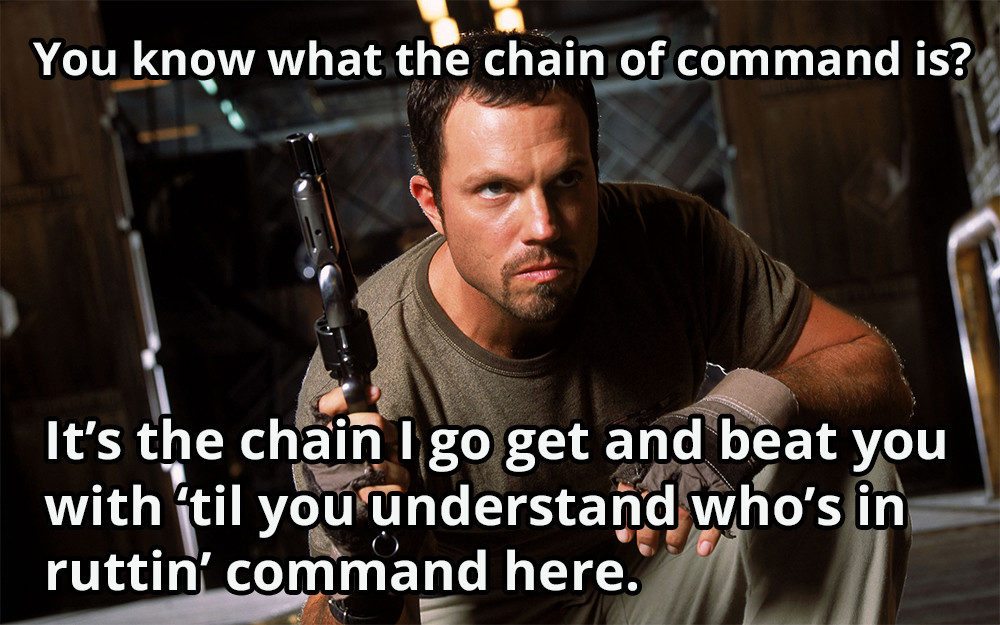
The first character that comes to mind when I think of Type 8 is Jayne Cobb. He’s driven by his Id and the need to be the toughest guy around.
But he’s so stereotypically not-so-healthy Eight that it’s really not fair to the more heroic Eights out there, the ones that are true leaders. Nick Fury for one. I’ve seen Peggy Carter described as an Eight, too, though I’m not as sure about that. Well, why not. She desires control and independence, she’s assertive and just, and if she’s going to punch you in the face she’s just going to do it, nothing fancy about it. All right, I can see it.
Come to think of it, you know who else is an Eight, as much as her society would allow a woman to be so? Elizabeth Bennet. Mr. Darcy is probably a Five, though he might look Fourish depending on who’s playing him in the adaptation. But I will never doubt her sister Jane’s type. Jane AND her beloved Charles Bingley get into all their troubles because they are both clearly…
Type Nine
Sometimes Called: the Peacemaker or the Mediator
Basic Desire: stability and harmony
Known for being: easygoing, selfless, accepting
But on the flip side: tend to be indecisive daydreamers with little sense of self, really bad at prioritizing. Your Deadly Sin is: sloth
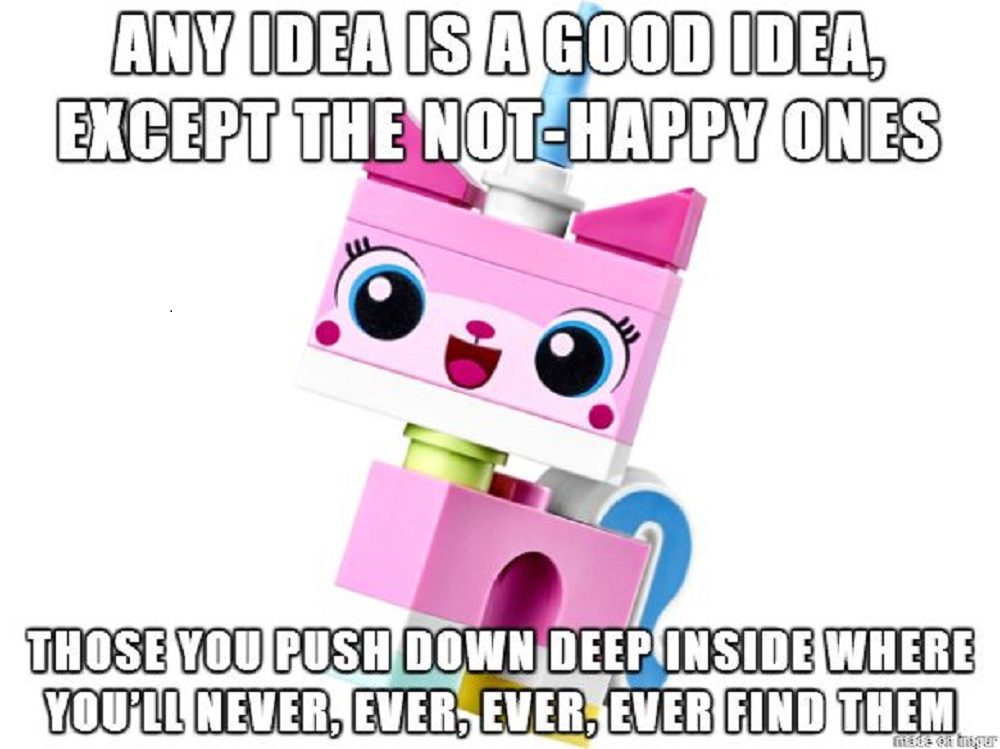
Hi there. *waves bashfully* Meet me.
If Riley in Inside Out had been a NINE, Joy would have wandered off to look at the pretty thoughts, Fear and Disgust would be forcefully sitting on Anger to repress him, and every so often Sadness might tentatively reach for the controls–although while there she would pretend to be Joy. We Nines appear serene and somewhat vacant (when I first discovered Luna Lovegood, I thought “OMG I’VE finally made it to Hogwarts!”), but inside we’re in chaos. Not that we usually bother to pay attention to the chaos. If we paid attention, we’d get totally overwhelmed by all the options. Being really good at seeing all sides of a situation makes us really, really indecisive. Plus, we don’t want to offend anyone if, in their opinion, we make the wrong choice. More than anything, all we want is for everyone to just get along, even if that means repressing our own needs and feelings.
Occasionally all the little microaggressions that seemed to roll off our backs will finally build up and we’ll explode over the proverbial last straw. I explode by crying. Bruce Banner explodes by turning into the Hulk. Maybe that’s a little extreme of an example of the Type 9 issue with repressing anger, but it’s revealing, too. When in The Avengers he says, “That’s my secret. I’m always angry,” it instantly made sense to me as a Nine. Banner is actually being a HEALTHY Nine here: he’s aware of the anger constantly writhing underneath and has learned to unleash it with intent and purpose. Intent and purpose are things a less-healthy Nine has trouble with. We’re more likely to absorb uncomfortable feelings until we freeze up into a catatonic depression, like Katniss’s mother did after her husband died, or ever more irrationally insist that everything is perfectly all right as we make more and more of a mess of things through our denial, like the current state of my house for example, or worse, like one of my newer favorite unhealthy Nines of pop culture, Peggy Blumquist of the Fargo TV series.

We Nines are very good at making ourselves invisible, so as not to bother anybody. But we get so good at being invisible that we can sort of panic when we actually want to be noticed, and ramble on and on because we assume that nobody heard us the first time, so, sorry about the disproportionate length of my Type 9 description here. Oh, we also tend to apologize too much.

Intrigued? You might want to try a few online tests. I say “a few” because it’s not always easy to answer these questions accurately enough because they really force you to look deep inside yourself at things you usually do unconsciously. You’ll want to think about the things you’ve repeatedly struggled with all your life, the things people have often said about you, and your gut feelings. Compare your results from several tests to see what keeps popping up. Read descriptions of possible types from several sources. If a test gives you your top few results, read the descriptions of each. You’ll probably relate to different things in each of the results, but you’ll know when you find your true core type because it’ll punch you in the gut. Uh-oh, you’ll think, I’ve been FOUND OUT!
The free test here is the first one I took, which so intrigued me I ended up taking the paid test because I’m a sucker. The whole site is full of great information from two of the foremost Enneagram experts, who also wrote the authoritative book on the subject, The Wisdom of the Enneagram.
The long test here is pretty accurate, the shorter test less so, but it gives you your top few results so you can compare.
This test has you compare cards with concepts relating to each type, so it’s fairly easy. More importantly, the site has very detailed type descriptions.
This site has a lot of great information from a practical life-improvement perspective, but it’s really annoying to navigate. If you’re really interested, though, I encourage you to persevere and click through the not-particularly-intuitive menu, because there’s some great insights and practical examples I haven’t seen anywhere else.
This site doesn’t have a free test but does have some nice descriptions and videos of how each type really presents themselves.
Happy Journey-of-Self-Discovery to you!


